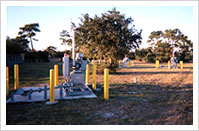Remediation of Chlorinated Solvents
Project Location: SW Florida
Client: DoE
Contamination: TCE, PCE, Vinyl Chloride, Toluene
Site Size: 4+ Acres
 Project Description: Over the previous 13 years, the incumbent remediation contractor had attempted to removed a large chlorinated solvent plume extending 20+ feet below grade, covering a footprint of approx. 4+ acres, with an elaborate vertical well pump-and-treat system. The cost expended by the Client to date exceeded $13 million. We knew we could do far better, and we did.
Project Description: Over the previous 13 years, the incumbent remediation contractor had attempted to removed a large chlorinated solvent plume extending 20+ feet below grade, covering a footprint of approx. 4+ acres, with an elaborate vertical well pump-and-treat system. The cost expended by the Client to date exceeded $13 million. We knew we could do far better, and we did.
Based upon a review of archived documents, we projected that the incumbent contractor would be removing, at best, just under 30 pounds of contaminants that year from the site, with chronological removal rates having markedly decreased every year since they began their work. This fact irrefutibly indicated that the site would never clean up. The Client was desperate to complete remediation so the site could be turned over to the community for a much needed park. We were asked to intervene and determine how to clean up all of the contamination completely and quickly.
Our approach was to employ concurrent in situ co-metabolic bioremediation and in situ air stripping to remediate the site using horizontal well deployed biosparge systems. Since the plume contained not only chlorinated solvents and daughter products (TCE, DCE and vinyl chloride) as well as toluene, we were confident that co-metabolic bioremediation would work quite well.
Using our proprietary FEA CFD design and analysis software SPARGE™ and DISPERSION™, we were able to model the horizontal well systems perfectly, so that their 3-D placement underground was precisely known such that when operated the injected air would encapsulate the existing contaminant plume with a fully enclosed air curtain. IN SITU STRIPPER™ also modeled the fate of each compound as it concurrently stripped from the formation.
We used SYSTEM DESIGN’R™ to design and specify the motive equipment. In all, we designed and installed three horizontal well biosparge systems to remediate the 4.5 acre site.
Our analyses indicated that the site would remediate very quickly, on the order of several months, and we were proven to be right. Within 6 months of system start-up, none of the previously found contaminants were identified in any monitor well sample. Several rounds of sampling were directed by the Client over a period of several more months, all similarly indicating “non-detect” for each of the contaminant species.
In all, employing its previous remediation contractor, the Client invested more than one decade and millions of dollars pursuing site cleanup using an approach and techniques that could not possibly work. We completed site clean up in less than 6 months at a very small fraction of this cost.